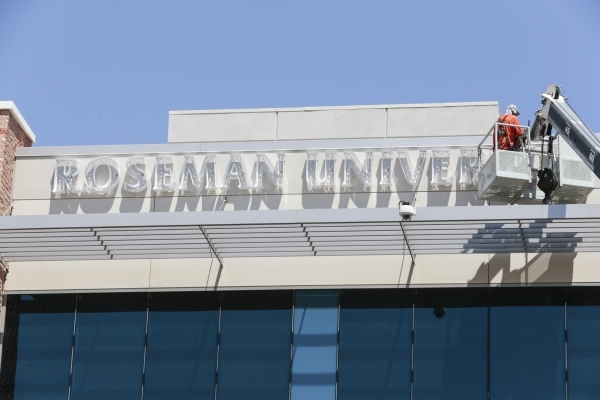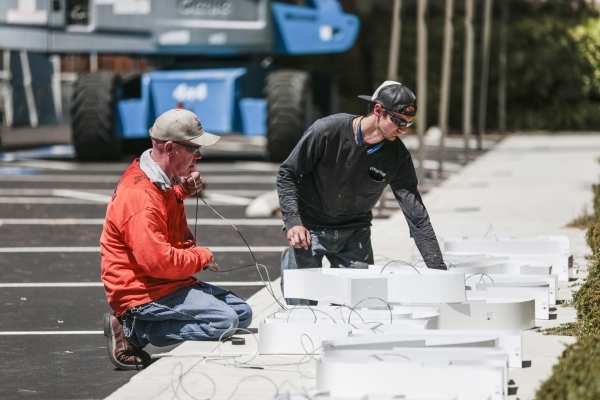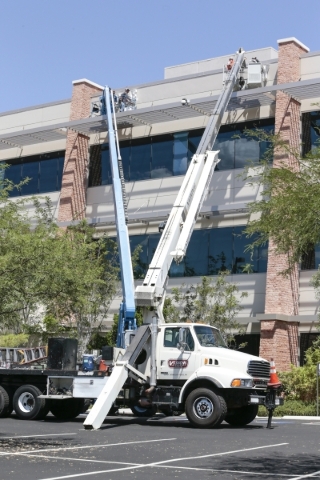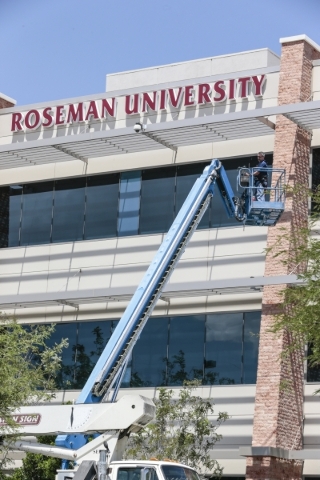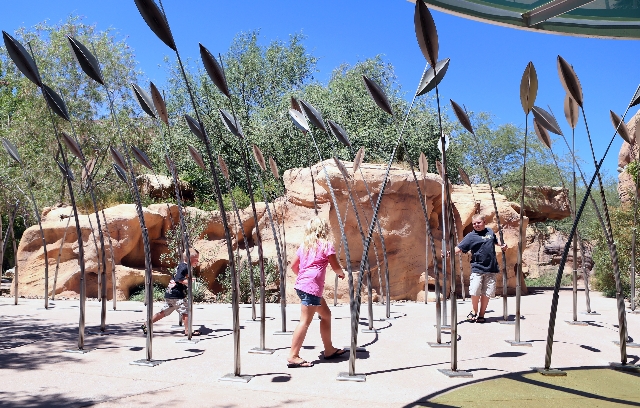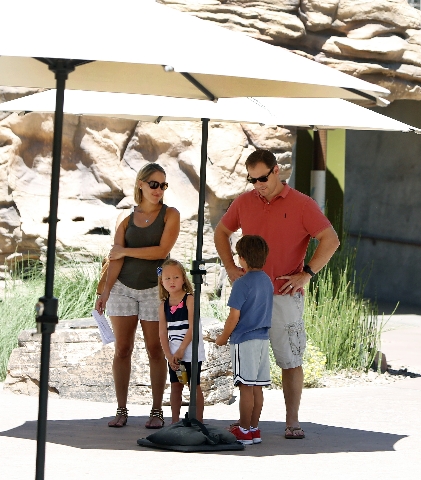New medical schools will shift doctors’ affiliations, move students around Nevada
Opening two new medical schools in Southern Nevada will bring more than brick and mortar changes.
Doctors who also teach will shift affiliations, and some students will end up on opposite ends of the state.
The University of Nevada School of Medicine in Reno has been training students in the Las Vegas Valley for more than 20 years. But the creation of the UNLV School of Medicine will result in the Reno school moving most of its operations north, including third- and fourth-year students.
When students in the University of Nevada, Las Vegas' charter class start school a little more than two years from now, most of the physician faculty affiliated with the school in Reno will be teaching UNLV medical students.
A few of the doctors with UNR's medical school might move north, some will be jointly affiliated, but most will become the new faculty for UNLV's planned school. The change will end the practice of Reno medical students spending their first two years in the north in primarily classroom settings and their third and fourth years in Southern Nevada in clinical rotations.
PRIVATE VS. PUBLIC
The changes in the state schools separate UNLV officials from their counterparts at Roseman University of Health Sciences who have taken another significant step in their accreditation process.
Officials at the private, nonprofit Roseman already have submitted a self-study to the Liaison Committee on Medical Education, the accreditation agency for U.S. and Canadian programs offering medical doctor degrees.
The two medical schools had been on roughly parallel paths toward accreditation, but Dr. Barbara Atkinson, planning dean of the UNLV medical school, said the self-study for her facility won't be submitted until the fall to allow input from the physicians coming on board.
The University of Nevada School of Medicine has 330 part-time community physicians in Las Vegas who volunteer their time and 219 full- and part-time faculty members who teach, conduct research and treat patients in Las Vegas. Atkinson said she will find a spot at the UNLV School of Medicine for all of those physicians who want to continue teaching. Some of the faculty might find a home at Roseman.
Both schools continue to plan for having the capacity to teach 60 medical students each year starting in 2017, the first time two medical schools have been planned in such close proximity at one time. Both schools have strengths to stress to the Liaison Committee on Medical Education, which will consider all aspects of their programs, from curriculum to faculty to facilities to resources to potential clinical sites, before allowing student recruitment.
Atkinson and Dr. Mark Penn, dean of the planned Roseman school, are confident their institutions will make the grade.
Penn said one of the strengths of his self-study is a plan to have all students well-grounded in community clinics in Southern Nevada for their first three years in the school. The plan still is being refined, but the goal will be to require students to learn about the residents who make up their patient pool. That will help get the students invested and active in the communities where they're training, Penn said.
"The students are getting to know not only the practice of medicine, because they get to know all the providers, but they also have to learn about the community around their site" Penn said. "This is more about connecting with the neighborhood. That's the top priority."
UNLV students also will spend time in such clinics, Atkinson said, because the future of medicine will be more outpatient than inpatient. Planning for the new school includes the creation of UNLV School of Medicine primary care clinics.
"This way, the students get embedded into the community," Atkinson said. The clinics will be "aimed at Medicaid patients because they're the ones having a hard time getting to see doctors now."
The expansion of Medicaid through the Affordable Care Act has expanded the number of adults eligible for the program.
Both deans say early exposure to community clinics will encourage their students to consider a career as a primary care physician because the need for such practitioners is so great in Southern Nevada. The goal of both schools is to develop programs to address Nevada's doctor shortage. The state consistently ranks near the bottom of number of physicians per capita, and the medical schools, while still years away from graduating their first class, have been touted as a key component to boost the number of doctors serving Nevadans.
With a major boost from the Engelstad Family Foundation, UNLV officials raised enough to have scholarship money available for the entire charter class of the medical school. The Engelstad commitment also will provide scholarships to 25 UNLV students per year for three years after charter class begins.
"We're already getting calls every day from kids across the country who are interested," Atkinson said. "But we're not allowed to talk to them until we get Liaison Committee on Medical Education accreditation."
UNLV and Roseman are applicant schools, and their accreditation will be weighed by the Liaison Committee on Medical Education in meetings next year, Roseman in June and UNLV in October. In those meetings, the schools plan to achieve preliminary accreditation.
NEED 'TWICE AS MANY' ROTATIONS
Atkinson and Dr. Thomas Schwenk, dean of the School of Medicine in Reno, have a target date of July 1, 2017, when current faculty based in Las Vegas will convert to UNLV. The change also will affect residency programs at University Medical Center, Sunrise Hospital and the North Las Vegas VA Medical Center. The change means Reno medical students will remain up north instead of spending their third and fourth years of school in the Las Vegas area.
In the interim, Schwenk will be developing new clinical sites in the north for his students. The Reno school will continue its affiliation with a residency program being developed at Mountain View Hospital in Las Vegas. Reno students also will be able to take advantage of working in UMC's trauma center and other specialties only available in Southern Nevada.
Schwenk said the change will give his students more options, and the educational experience will be improved for those who choose to complete all four years of school in Northern Nevada. Coincidentally, the Reno school is going through its re-accreditation process at about the the same time Roseman and UNLV are looking to get accredited.
Having half a school in Reno and half a school in Las Vegas 450 miles apart never was an easy sell, Schwenk said.
"We're developing full capacity in surgery, OB-GYN, neurology, all the primary care disciplines," he said. "We think that being all in one place with selective experiences in Las Vegas will be way more attractive."
State Sen. Joe Hardy, a Reno medical school alum who teaches with Touro University Nevada's School of Medicine, said he has concerns that the medical schools will have the clinical sites to accommodate all the students and is encouraged at the expansion of those sites in Northern Nevada. Hardy is confident Schwenk will find the clinical sites he needs in the north, but he wonders how all the students from the Touro, UNLV and Roseman will find clinical sites. Altogether, those schools will be admitting more than 250 medical students per year starting in 2017.
"We're going to need nearly twice as many clinical rotations as we have now," Hardy said.
But Hardy is more encouraged than concerned with recent developments in doctor training opportunities in Nevada. The Legislature's approval of $10 million for graduate medical education, the training doctors need before they can be licensed and practice independently, offers another important factor in addressing Nevada's doctor shortage.
"If you don't have the residents, you don't have the teachers of the medical students," he said.
Contact Steven Moore at smoore@reviewjournal.com or 702-380-4563.





